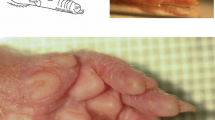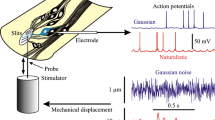Summary
-
1.
Sensory transduction was studied in dorsal skin mechanoreceptors of the frog,Rana pipiens. The skin was clamped and stretched before being stimulated with the tip of a glass rod mounted on a servo-controlled loudspeaker. Afferent activity was recorded extracellularly from a dorsal cutaneous nerve.
-
2.
Three groups of sensory units could be identified by the size of their recorded action potentials and their response to mechanical stimuli. Action potential amplitudes for the three groups were: <50 μV (group I), 50–250 μV (group II) and > 300 μV (group III). Group II were selected for further study because of their amplitude and their resistance to fatigue.
-
3.
Three types of mechanical stimuli were used to examine the dynamic properties of group II receptors, steps, sinusoids, and band-limited random displacement. In each case the responses could be well fitted by a power-law model with a fractional exponent of time or frequency.
-
4.
Random stimulation of a large number of group II receptors showed considerable variability in their sensitivity and in their dynamic behavior, as measured by the fractional exponent of frequency. However, the distributions of these two parameters were both unimodal and strongly clustered around the modes, suggesting that the recordings were from a single class of receptors.
-
5.
Varying the temperature of the receptors had little effect on their sensitivity or dynamic properties. This is in contrast to findings on other mechanoreceptors.
-
6.
Doubling the potassium concentration in the bathing solution affected the dynamic properties of the receptors within 5 min but several distinct patterns of change in dynamic behavior were seen.
-
7.
The mean conduction velocity in the afferent nerves was 2.84 m/s. On this evidence we suggest that free nerve endings are the most likely morphological class of receptors to be responsible for group II responses.
Similar content being viewed by others
Abbreviations
- r.m.s. :
-
root mean square amplitude
References
Bendat JS, Piersol AG (1980) Engineering applications of correlation and spectral analysis. Wiley Interscience, New York
Bohnenberger J (1981) Matched transfer characteristics of single units in a compound slit sense organ. J Comp Physiol 142:391–402
Catton WT (1958) Some properties of frog skin mechanoreceptors. J Physiol 141:305–322
Catton WT, Petoe N (1966) A visco-elastic theory of mechanoreceptor adaptation. J Physiol 187:35–49
Chapman KM, Smith RS (1963) A linear transfer function underlying impulse frequency modulation in a cockroach mechanoreceptor. Nature 197:699–701
During M, Seiler W (1974) The fine structure of lamellated receptors in the skin ofRana esculenta. Z Anat Entwickl Gesch 144:165–172
Fessard A, Segers M (1943a) Dualité des récepteurs tactiles chez la grenouille. CR Soc Biol Paris 136:666–667
Fessard A, Segers M (1943b) Quelques charactères différentiels des récepteurs cutanés chez la grenouille. CR Soc Biol Paris 137:212–213
French AS (1970) Pulse: an event/time histogramming program. Comp Prog Biomed 1:105–117
French AS (1973) Automated spectral analysis of neurophysiological data using intermediate magnetic tape storage. Comput Prog Biomed 3:45–57
French AS (1984) Action potential adaptation in the femoral tactile spine of the cockroach,Periplaneta americana. J Comp Physiol A 155:803–812
French AS, Holden AV (1971) Alias-free sampling of neuronal spike trains. Kybernetik 8:165–171
French AS, Kuster JE (1981) Sensory transduction in an insect mechanoreceptor: extended bandwidth measurements and sensitivity to stimulus strength. Biol Cybern 42:87–94
French AS, Kuster JE (1982) The effects of temperature on mechanotransduction in the cockroach tactile spine. J Comp Physiol 147:251–258
French AS, Holden AV, Stein RB (1972) The estimation of the frequency response function of a mechanoreceptor. Kybernetik 11:15–23
Ishiko N, Loewenstein WR (1961) Effects of temperature on the generator and action potentials of a sense organ. J Gen Physiol 45:105–124
Kuster JE, French AS (1983) Sensory transduction in a locust multipolar joint receptor: the dynamic behavior under a variety of stimulus conditions. J Comp Physiol 150:207–215
Landgren S (1953) On the excitation mechanism of the carotid baroreceptors. Acta Physiol Scand 26:1–34
Lindblom U (1962) The relationship between stimulus and discharge in a rapidly adapting touch receptor. Acta Physiol Scand 56:349–361
Loewenstein WR (1956) Excitation and changes in adaptation by stretch of mechanoreceptors. J Physiol 133:588–602
Marmarelis PZ, Marmarelis VZ (1978) Analysis of physiological systems, the white noise approach. Plenum Press, New York
Murphy BF, Heath JE (1983) Temperature sensitivity in the prothoracic ganglion of the cockroach,Periplaneta americana, and its relationship to thermoregulation. J Exp Biol 105:305–315
Nafstad PHJ, Baker RE (1973) Comparative ultrastructural study of normal and grafted skin in the frog,Rana pipiens with special reference to neuroepithelial connections. Z Zellforsch 139:451–462
Ogawa H, Morimoto K, Yamashita Y (1981) Physiological characteristics of low threshold mechanoreceptor afferent units innervating frog skin. Q J Exp Physiol 66:105–116
Ogawa H, Yamashita Y (1982) Patterns of impulses discharged by slowly adapting cutaneous mechanoreceptive units in the warty skin of frogs in response to prolonged displacements. Jpn J Physiol 32:945–958
Ritchie JM (1982) On the relationship between fibre diameter and conduction velocity in myelinated nerve fibres. Proc R Soc Lond B 217:29–35
Roberts A, Hayes BP (1977) The anatomy and function of ‘free’ nerve endings in an amphibian skin sensory system. Proc R Soc Lond B 196:415–429
Spekreijse H, Oosting H (1970) Linearizing: a method for analysing and synthesizing nonlinear systems. Kybernetik 7:22–31
Thorson J, Biederman-Thorson M (1974) Distributed relaxation phenomena in sensory adaptation. Science 183:161–172
Whitear M (1955) Dermal nerve endings inRana andBufo. Q J Microsc Sci 96:343–349
Whitear M (1977) A functional comparison between the epidermis of fish and amphibians. Symp Zool Soc Lond 39:291–313
Author information
Authors and Affiliations
Rights and permissions
About this article
Cite this article
Watts, R.E., French, A.S. Sensory transduction in dorsal cutaneous mechanoreceptors of the frog,Rana pipiens . J. Comp. Physiol. 157, 657–665 (1985). https://doi.org/10.1007/BF01351359
Accepted:
Issue Date:
DOI: https://doi.org/10.1007/BF01351359




